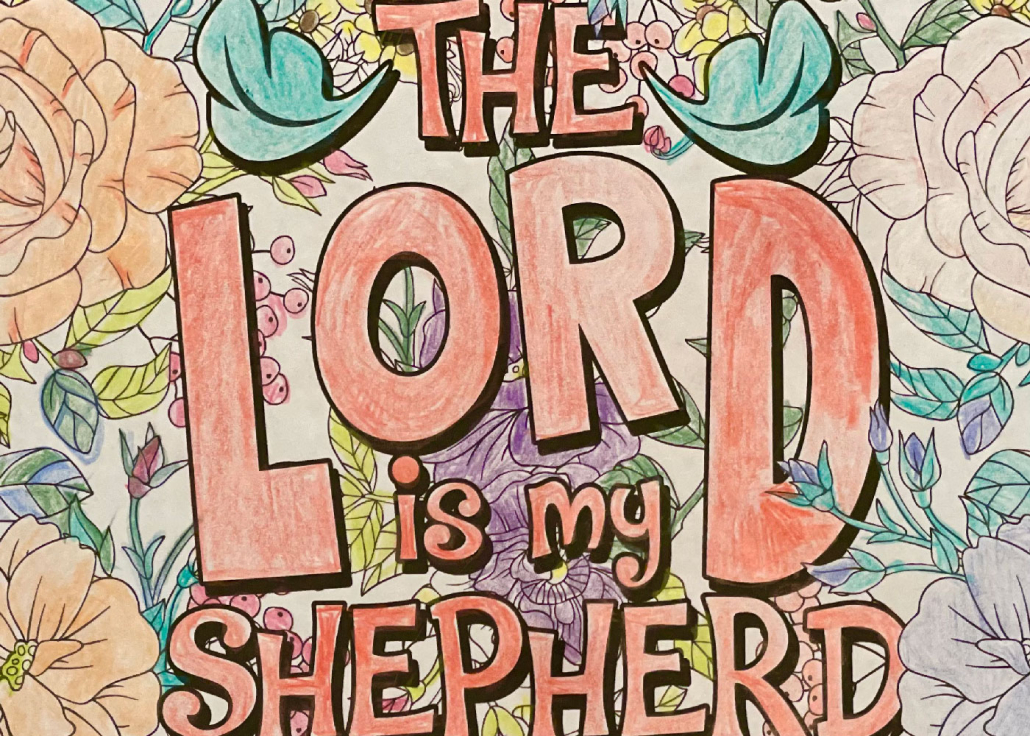Image: Colouring by Jane Hogan, 2023.
‘A way in and a way out’
Andrew Collis
Easter 4, Year A
Psalm 23; John 10:1-10
Jesus, John invites us to imagine, is a gate.
The metaphor allows many meanings – its expression looms large (just the right size) at the entrance to SSUC, the handiwork of unknown miners and metalsmiths, as well as Cathie, Bernie and André … and soon to be spray-painted heritage green!
Our interactive online worship and small group meetings similarly involve gates, passwords, thresholds, interludes …
Christ – and by implication Christian or Christa community (Nakashima Brock) – means liberty, liberation. There is something life-preserving and life-sustaining on offer. In contradistinction, we are given a negative image of traps, shortcuts and break-ins, charlatans and plunderers.
Jesus says, “I am the gate.” It is by constant interaction with Jesus – the gospels, gospel values, provocations and promises – in prayer and practice – that believers find what John’s gospel calls “abundant life” – qualitatively enhanced life – participation as “children of God” in divinity-humanity.
I imagine a gate between one image and another – the very model of metaphor. In this sense, Christ is the logos, the poiesis (bringing-forth) of the kindom as both freedom and non-separation; a poetics of faith, hope and love …
The gospel leads to reverence for Jesus the preserving/sustaining One as to reverence for sheep, goats, dogs, cats, hens and all creatures that move upon/within the Earth … all creatures that crawl, run, hop, fly, swim to-and-fro … in and out of human consciousness …
One means of avoiding closed interpretations (whether gnostic or fantastic) is to ask, with Jesus: How might I, too, become a gate? How might we offer – to neighbours and strangers – a way in and a way out?
“Together we are the body of Christ, and individually members of it,” says the apostle Paul …
I recall a requiem mass for our friend Greg Symons, beloved partner of Carolyne. The mass was held three years ago at St Mary’s Catholic Church in Erskineville.
There was a small gathering, an open casket, cantors, various ritual elements – liturgical procession with the Easter candle, sprinkling of the casket with holy water, chanting of prayers, a limited Eucharist (due to Covid restrictions) …
My first thoughts were critical. The liturgy was overly long and lacked emotion.
By the time we’d processed out of the church and paid our final respects in song as the hearse moved away, however … by the time we were back inside the church to watch a slide presentation of key moments and people in Greg’s life, my thoughts had changed, my imagination moved to wonder.
I realised I was part of something that transcended the merely moral or sentimental. We were not there simply to weep for Greg, nor merely to reminisce or romanticise.
What mattered was that we were together. We endured the rituals, we said the prayers, recited gospel provocations and promises. The priest mentioned “heaven” such that we could sense it. We wanted to see Greg in heaven because we all wanted it. The mass was about us, the body of Christ, and we were the gate to heaven.
Estranged members of Greg’s family exchanged signs of peace. We celebrated forgiveness (for all), grace (for all). The rituals applied a gentle pressure and the door opened, into the church, out of the church … and back in …
We were together. We are together …
We lean in (Sheryl Sandberg) – as believers and journalists, believers and artists, believers and gardeners – in neighbourhoods with high disparities – to demand affordable childcare and a social safety net for the young and the old. We lean in to demand the raising of unemployment benefits and student support payments.
We insist on education for all; homes (with wi-fi) for all (building public and affordable housing, doubling rental assistance); urgent climate action – no new coal, oil or gas; 100 per cent renewables by 2030; funding for a just transition and jobs.
We welcome change in attitudes, empathy for the most vulnerable, a new world of possibilities (including constitutional recognition of First Nations – consultation with representatives of First Nations) …
Jesus says, “I am the gate.” There is something important here regarding faithfulness, something about working together patiently and with compassion. Jesus is a gate because he lays his body on the line (between the stones comprising the wall to the sheepfold) …
And the voice resonates. The good news is heard. How might I, too, become a gate? How might we offer – to neighbours and strangers – a way in and a way out? Amen.




